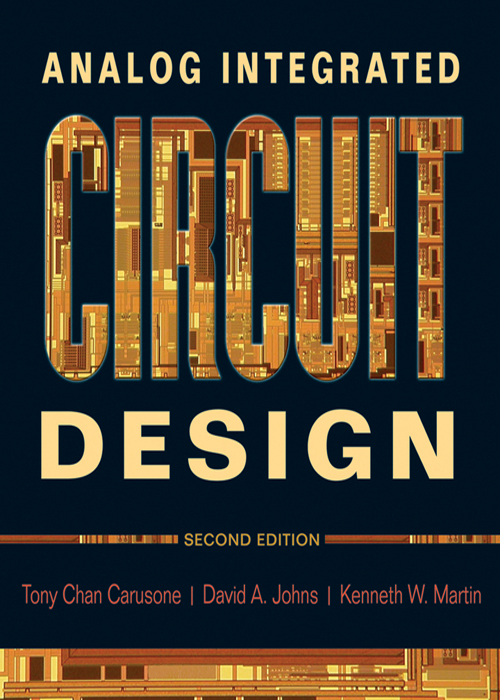Analog.Integrated.Circuit.Design.Martin.Johns.Martin,.Carusone.2ed【2012新书】:
- VP and Publisher Don Fowley
- Associate Publisher Dan Sayre
- Editorial Assistant Charlotte Cerf
- Senior Marketing Manager Christopher Ruel
- Senior Production Manager Janis Soo
- Senior Production Editor Joyce Poh
- This book was set in 9.5/11.5 Times New Roman PSMT by MPS Limited, a Macmillan Company, and printed and
- bound by RRD Von Hoffman. The cover was printed by RRD Von Hoffman.
- This book is printed on acid free paper.
- Founded in 1807, John Wiley & Sons, Inc. has been a valued source of knowledge and understanding for
- more than 200 years, helping people around the world meet their needs and fulfill their aspirations. Our
- company is built on a foundation of principles that include responsibility to the communities we serve and
- where we live and work. In 2008, we launched a Corporate Citizenship Initiative, a global effort to address the
- environmental, social, economic, and ethical challenges we face in our business. Among the issues we are
- addressing are carbon impact, paper specifications and procurement, ethical conduct within our business and
- among our vendors, and community and charitable support. For more information, please visit our website:
- www.wiley.com/go/citizenship.
- Copyright © 2012 John Wiley & Sons, Inc. All rights reserved. No part of this publication may be reproduced,
- stored in a retrieval system or transmitted in any form or by any means, electronic, mechanical,
- photocopying, recording, scanning or otherwise, except as permitted under Sections 107 or 108 of the 1976
- United States Copyright Act, without either the prior written permission of the Publisher, or authorization
- through payment of the appropriate per-copy fee to the Copyright Clearance Center, Inc. 222 Rosewood
- Drive, Danvers, MA 01923, website www.copyright.com. Requests to the Publisher for permission should be
- addressed to the Permissions Department, John Wiley & Sons, Inc., 111 River Street, Hoboken, NJ 07030-5774,
- (201)748-6011, fax (201)748-6008, website http://www.wiley.com/go/permissions.
- Evaluation copies are provided to qualified academics and professionals for review purposes only, for use in
- their courses during the next academic year. These copies are licensed and may not be sold or transferred to
- a third party. Upon completion of the review period, please return the evaluation copy to Wiley. Return
- instructions and a free of charge return shipping label are available at www.wiley.com/go/returnlabel.
- Outside of the United States, please contact your local representative.
- Library of Congress Cataloging-in-Publication Data
- Carusone, Tony Chan.
- Analog integrated circuit design / Tony Chan Carusone, David A. Johns, Kenneth W. Martin. —2nd ed.
- p. cm.
- Includes index.
- Prev ed. listed under David A. Johns.
- ISBN 978-0-470-77010-8 (pbk.)
- I. Johns, David, 1958 II. Martin, Kenneth W. (Kenneth William) 1952 III. Johns, David, 1958- Analog
- integrated circuit design. IV. Title.
- TK7874.J65 2011
- 621.3815—dc23
- 2011039275
[hide]
[/hide]
{:7_1234:}
一有新书,微网就出得那么快!正需要!
{:7_1234:}
Analog.Integrated.Circuit.Design.Martin.Johns.Martin,.Carusone.2ed
need know something inside chipset
感谢分享
新书啊,这么快就出来了,顶
谢谢老大分享,是2012年的新书
真是新书啊
感謝分享!{:soso_e100:}
好书,新书,谢谢分享。
顶顶顶
支持,感谢
thanks!!!!!!!!!!!!!!!!!!!!!!
thanks!!!!!!!!!!!!!!!!!!!!!!!!!
:19bb:49bb
是书都要收藏啊,保不准哪一天就用上了
好好好好好好哈
need know something inside chipset
多谢分享啊
{:7_1234:}
好东西,大家分享,谢谢了
都说最近新书很多啊。
好东西啊!但是要看完估计需要些耐力啊!
{:7_1234:}{:7_1234:}{:7_1234:}
{:7_1234:}
kankan.....................
太强了吧
这些书哪里找到的?
很高深啊
好好好好好好哈
這麼好的一本書
怎麼可以錯過呢
感謝樓主分享
谢谢楼主分享
haoshu ,kankan!
2012的书都有啊,厉害!
感谢分享,我下了,但不知咋地解压不了,求指导
应该是相当不错的一本书,收藏!
一有新书,微网就出得那么快!正需要!
这个文件根本不能解压的
baiquan 发表于 2012-3-18 23:20
这个文件根本不能解压的
多搜索下使用方法!
看上去很不错的书咯。
谢谢大家支持
感谢楼主分享
看看,什么情况
看看~感觉很有用~!
zzzzzzzzzzzzzzzzzzzzzzzzzzzzzzzzzzzzzzz
好书,谢谢楼主分享!!
支持 下来看看··· 呵呵
感谢分享
微网就是so big
谢谢分享
看见模拟的东西就反胃
谢谢楼主好书!
谢谢 好东西!
{:7_1234:}{:7_1234:}{:7_1234:}
好动洗好懂得系 好东西
回复看看
thanks........
好东西啊,学习学习
新书,看看
{:soso__16984349925490629196_1:}
kkb
非常感谢楼主哈~~~
感谢分享{:soso_e100:}
一有新书,微网就出得那么快!正需要!
thank for your share
不错。。。
thank you very much for sharing
ernest0512
非常感谢!!!!!!!
学习一下了
学习学习!
谢谢!
呵呵!
怎们解压缩呀?
谢谢1
知道了,用7-zip可以解压缩的。呵呵!
thanks~
微网就是好啊
新书,要看一看!
好,很好。
支持
好书啊
学习学习。。。。。。。
长篇大作。多谢
很不错的一本书,感谢分享!
支持一下,感谢楼主
支持一下,感谢站长
、、、、、好东西啊!!!!!!!!!!!
谢谢楼主
好,顶
Analog.Integrated.Circuit.Design
极其期待啊啊
really cool
学习了 谢谢
顶一下~~~~~~
非常感谢楼主啊
想看看,多谢
感谢分享
看看是不是要找的那本经典
thnaks for share
謝謝分享 辛苦摟
感谢楼主,学习下~~~~~~~~~~~~~~~~~~~~~~~~~~~~~~~
那么好的东西,下载
谢谢楼主分享~~~
新书收藏
这个新的,看看如何
好多啊,楼主辛苦了
dingdingiding
想做芯片,多多学习
终于找到这本书了啊,多谢了啊啊啊
新书哦,谢谢楼主喽~~~~
还要隐藏啊
感謝分享
謝謝分享,下來学习了
好书,新书,谢谢分享
thanks forsharing
感谢!
好书,顶起!
非常感谢
感谢楼主分享~
看看,谢谢
Thank you very much for share !!!!!!!!!!!!!!!!!!!!!!
支持,感谢
thanks you very much
谢谢楼主
经典资料,谢谢分享了
good, have to take a look
感谢楼主分享,@!!
{:7_1234:}{:7_1234:}
:16bb
赶快学习学习
好东西啊
相当的详细啊,覆盖面很广
hao!
Analog.Integrated.Circuit.Design.Martin.Johns.Martin,.Carusone.2ed
非常棒的一本书 新书绝对支持
谢谢分享新书
看起来好像很高级的样子
哇哦~
我顶顶顶!
非常给力,英文原版
好资料,谢谢楼主分享。
good book and thanks!
谢谢分享!{:7_1234:}
Analog.Integrated.Circuit.Design.Martin.Johns.Martin,.Carusone.
学习学习
集成电路设计,正好需要,下载先,多谢LZ
Great book! Just need it
路过 瞧瞧 谢谢
Good book THX LZ
下载下来看看
感谢分享
非常感谢!!!
最新力作吗,挑着看。
kankan xieixie
里面都是些什么内容啊
这是好东西奥
不错,又占了一个沙发!
{:7_1234:}楼主好人一枚。
一有新书,微网就出得那么快!正需要!:49bb
本帖隐藏内容请
一有新书,微网就出得那么快!
{:soso__3409329614010722382_3:}
支持啊。
Thank you for sharing
谢谢
多谢楼主分享
Thanks!
这本书很好,内容丰富。
kan kan, xie xie.
哈哈,我想看啊
very good and thanks
thanks for sharing
谢谢楼主分享
收藏,学习。
thanks for sharing
好书,下来看看
真给力啊
{:7_1254:}
好书,拜读拜读
xiexiefenxiang!
谢谢楼主,下来看看
什么时候要回复才能看到了啊
非常新的书,谢谢楼主及时雨
谢谢,需要看看
哪位同学请介绍一下怎么个解压法,谢谢,很多人不知道
谢谢LZ分享这么好的书,就像frankqs 说的下载后可以用7-zip提取文件
TK。谢谢楼主,,,
想看书就回复一下吧!
书在哪里呢????没有看到啊???
这么好的书,哪找啊
这么好的书,哪找啊
好书必须顶起
好书,学习一下
新书值得浏览
看看啊
analog integrated 2nd martin solution
路{:1_1356:}过看看
像frankqs 说的下载后可以用7-zip提取文件
內容好豐富喔!!
看看学习学习
感谢lz分享。。。
谢谢楼主!!
很有意思,看看能不能下
谢谢谢谢谢谢!
多谢楼主多谢楼主多谢楼主
好东西呵呵呵
尽管楼主已经上传好久了,遗憾的是我今天才看到。下载了,感谢楼主。
的顶顶顶顶顶大顶顶顶顶顶的顶顶顶顶顶顶顶顶顶顶的顶顶顶顶顶顶顶顶顶顶
下來看看~
谢谢楼主分享
谢谢楼主分享
谢谢楼主
多谢分享。
二锅头个哈哈哈天堂鸟今天能
